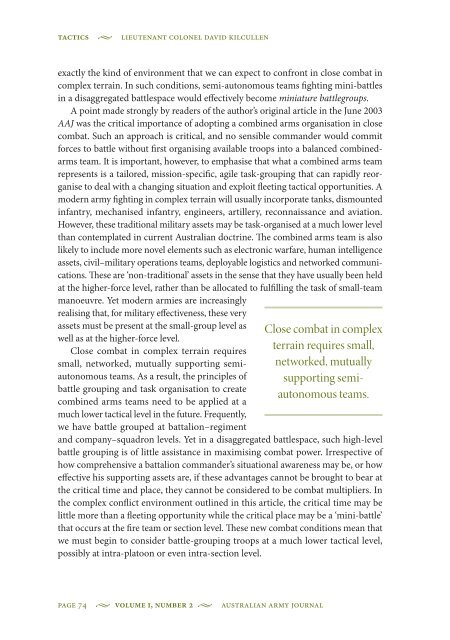The Essential Debate: Combined Arms and the ... - Australian Army
The Essential Debate: Combined Arms and the ... - Australian Army
The Essential Debate: Combined Arms and the ... - Australian Army
Create successful ePaper yourself
Turn your PDF publications into a flip-book with our unique Google optimized e-Paper software.
Tactics Lieutenant Colonel David Kilcullenexactly <strong>the</strong> kind of environment that we can expect to confront in close combat incomplex terrain. In such conditions, semi-autonomous teams fighting mini-battlesin a disaggregated battlespace would effectively become miniature battlegroups.A point made strongly by readers of <strong>the</strong> author’s original article in <strong>the</strong> June 2003AAJ was <strong>the</strong> critical importance of adopting a combined arms organisation in closecombat. Such an approach is critical, <strong>and</strong> no sensible comm<strong>and</strong>er would commitforces to battle without first organising available troops into a balanced combinedarmsteam. It is important, however, to emphasise that what a combined arms teamrepresents is a tailored, mission-specific, agile task-grouping that can rapidly reorganiseto deal with a changing situation <strong>and</strong> exploit fleeting tactical opportunities. Amodern army fighting in complex terrain will usually incorporate tanks, dismountedinfantry, mechanised infantry, engineers, artillery, reconnaissance <strong>and</strong> aviation.However, <strong>the</strong>se traditional military assets may be task-organised at a much lower levelthan contemplated in current <strong>Australian</strong> doctrine. <strong>The</strong> combined arms team is alsolikely to include more novel elements such as electronic warfare, human intelligenceassets, civil–military operations teams, deployable logistics <strong>and</strong> networked communications.<strong>The</strong>se are ‘non-traditional’ assets in <strong>the</strong> sense that <strong>the</strong>y have usually been heldat <strong>the</strong> higher-force level, ra<strong>the</strong>r than be allocated to fulfilling <strong>the</strong> task of small-teammanoeuvre. Yet modern armies are increasinglyrealising that, for military effectiveness, <strong>the</strong>se veryassets must be present at <strong>the</strong> small-group level aswell as at <strong>the</strong> higher-force level.Close combat in complex terrain requiressmall, networked, mutually supporting semiautonomousteams. As a result, <strong>the</strong> principles ofbattle grouping <strong>and</strong> task organisation to createcombined arms teams need to be applied at amuch lower tactical level in <strong>the</strong> future. Frequently,we have battle grouped at battalion–regimentClose combat in complexterrain requires small,networked, mutuallysupporting semiautonomousteams.<strong>and</strong> company–squadron levels. Yet in a disaggregated battlespace, such high-levelbattle grouping is of little assistance in maximising combat power. Irrespective ofhow comprehensive a battalion comm<strong>and</strong>er’s situational awareness may be, or howeffective his supporting assets are, if <strong>the</strong>se advantages cannot be brought to bear at<strong>the</strong> critical time <strong>and</strong> place, <strong>the</strong>y cannot be considered to be combat multipliers. In<strong>the</strong> complex conflict environment outlined in this article, <strong>the</strong> critical time may belittle more than a fleeting opportunity while <strong>the</strong> critical place may be a ‘mini-battle’that occurs at <strong>the</strong> fire team or section level. <strong>The</strong>se new combat conditions mean thatwe must begin to consider battle-grouping troops at a much lower tactical level,possibly at intra-platoon or even intra-section level.page 74 Volume I, Number 2 <strong>Australian</strong> <strong>Army</strong> Journal
















